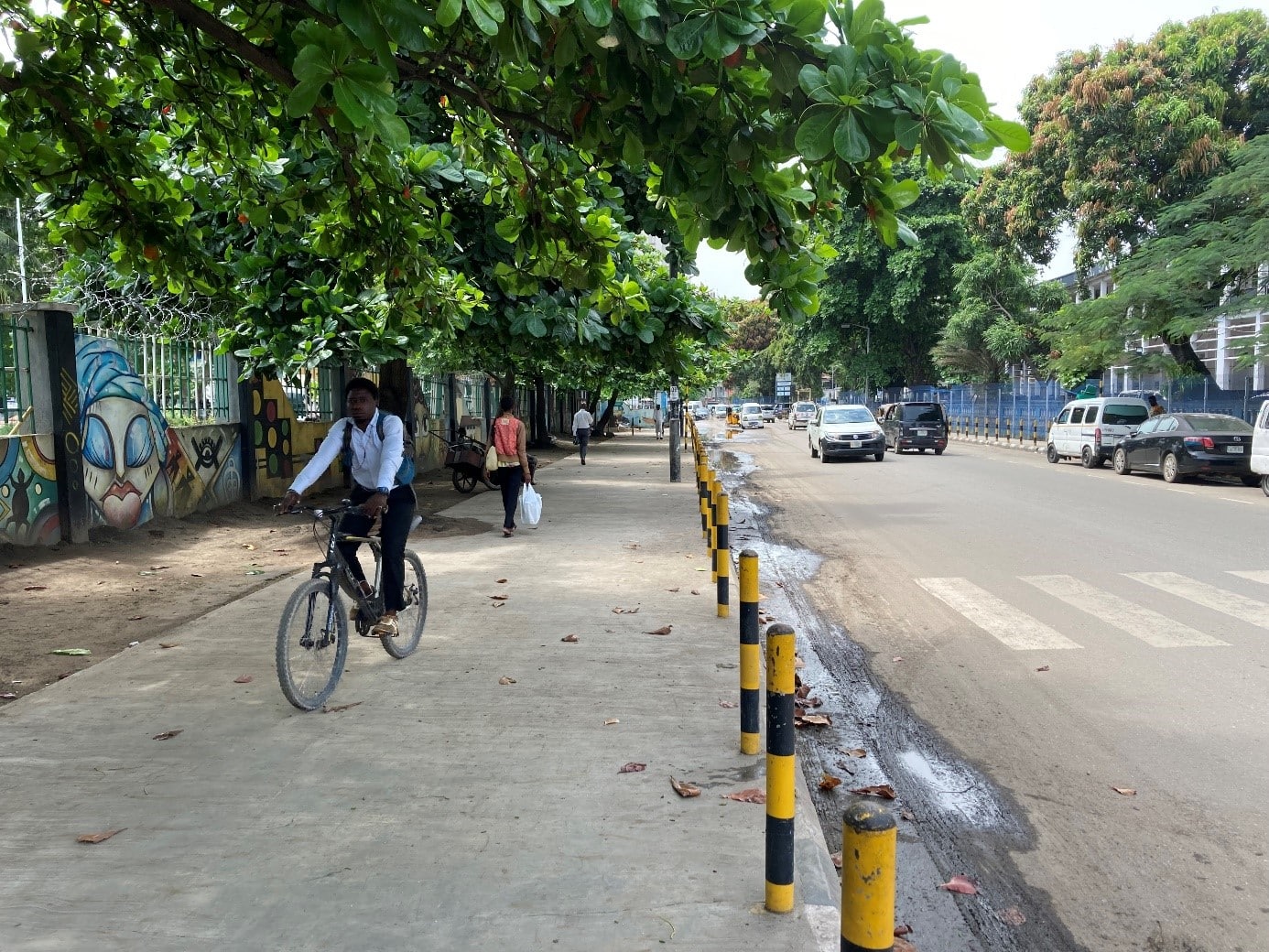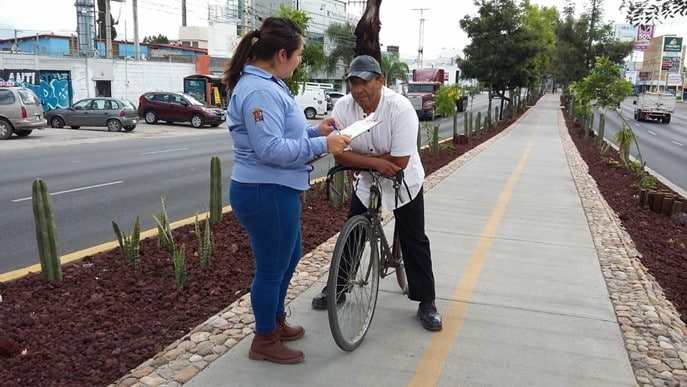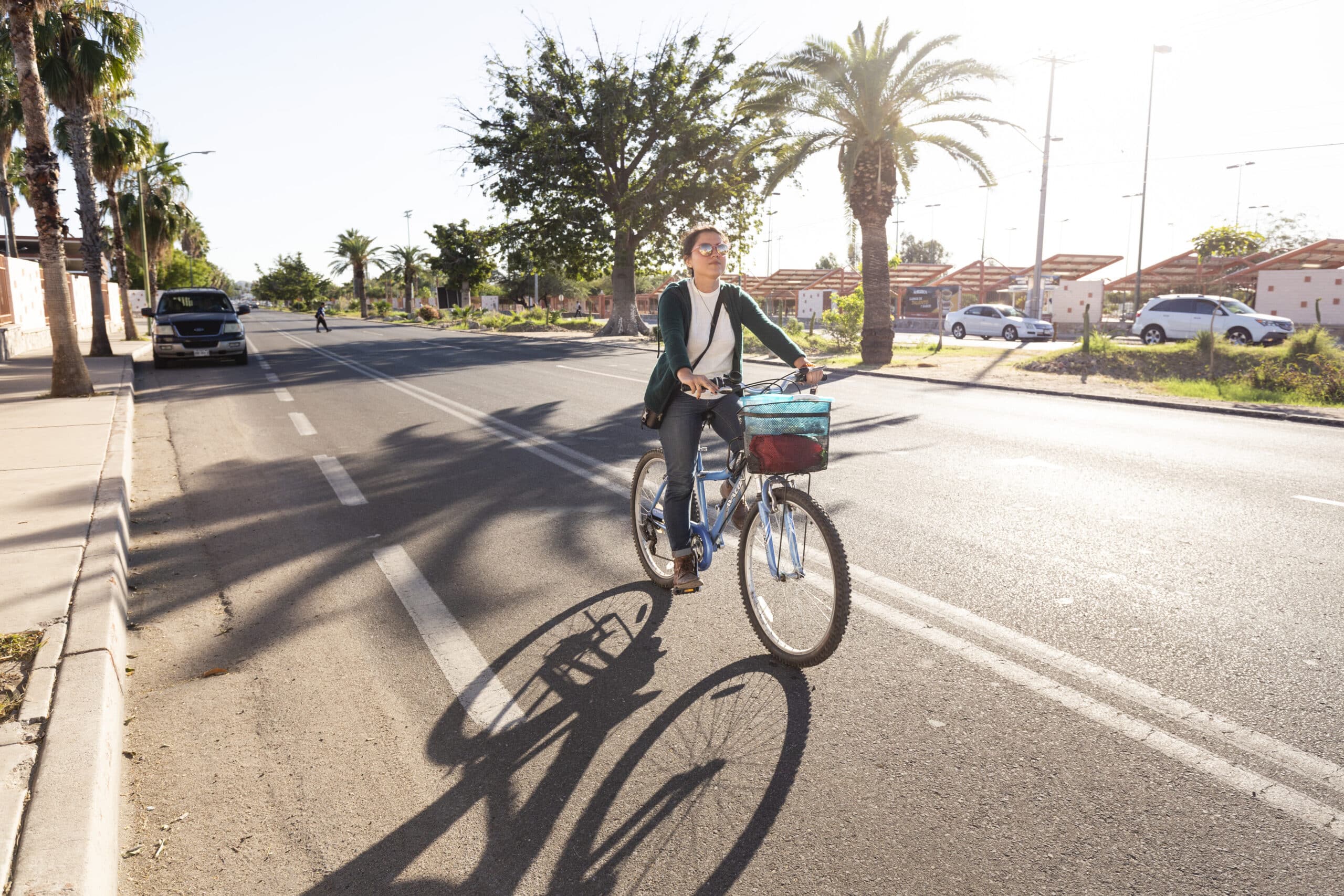As temperatures rise and extreme weather events become more frequent, cycling in hot climates poses a unique set of challenges. Just as extremely cold weather can deter cyclists (read our article on winter cycling here), scorching heatwaves can also discourage individuals from hopping on their bikes. However, cities around the world are proving that cycling can remain a viable and rational choice even in the face of adverse weather conditions. This article explores the obstacles faced by ‘summer cyclists’ and showcases inspiring solutions implemented by innovative cities.
The Challenges of Summer Cycling
The physical, infrastructural, and urban challenges of summer cycling are manifold. Cyclists grapple with the physical strain of exertion in high temperatures, enduring profuse sweating, dehydration, increased heart rates, stress on the body, sunburns, and heat strokes. These hurdles, reminiscent of the challenges faced by ‘winter cyclists’, can dissuade individuals from pedalling during the summer months.
Infrastructure also plays a crucial role in facilitating or hindering summer cycling. Insufficient urban greening and shade pose significant issues, as do the lack of green and blue infrastructure. When, in addition to that, cycling paths are not adequately separated from vehicular traffic, cyclists find themselves not only exposed to the harsh rays of the sun, but to noxious exhaust fumes, and uncomfortably sticky roads. Beyond that, the absence of showering, changing, and storage facilities in offices and buildings further discourages bike commuting. The built environment exacerbates these challenges through the urban heat island effect, where heat-absorbing pavements and buildings replace natural land cover, leading to higher temperatures in dense urban areas. Dust, eye and throat irritation, and an overall unpleasant environment further dissuade cyclists. The cumulative effect of these unfavourable conditions poses significant hurdles to summer cycling, particularly for longer distances.
How Cities in Hot Climates Promote Cycling
Despite these obstacles, cities across the globe have demonstrated that weather alone does not need to dictate the quality of the cycling experience. In Singapore, for instance, plans are underway to construct 700 kilometres of new bike lanes by 2030. These intra-town cycling paths, many of which will traverse shaded parks, aim to cater to both recreational cyclists and short commutes. With approximately half of these lanes already built, Singapore is also ramping up efforts to provide shower and changing facilities in office buildings, encouraging more office workers to embrace cycling.

© Singapore Land Transport Authority: design study for cycling infrastructure in Ang Mo Kio
Los Angeles, where summer temperatures lately reached maximum values of a scorching 40°C or higher, has prioritized cooling the city as a core objective. The city council aims to reduce average temperatures by 1.7°C by 2025 and by an ambitious 3°C by 2035. To achieve this, Los Angeles is increasing its green cover and implementing innovative cooling surfaces on streets and cycle lanes. These surfaces boast higher reflective coatings and, in some cases, cooling materials, effectively minimizing the heat radiating from concrete surfaces. The introduction of sun-reflecting coating (a water-based asphalt emulsion sealcoat) in a lighter colour, holds promise in countering the Urban Heat Island effect. Although this solution comes with a higher price tag, its potential benefits far outweigh the costs.
Mexico City, while generally enjoying a temperate climate, faces unique challenges due to the Urban Heat Island effect, altitude, and air pollution. Over the past 15 years, the city has made substantial efforts to develop cycling infrastructure and expand bike-sharing services. During the pandemic, the installation of temporary pop-up bike lanes resulted in a remarkable increase of up to 275% in daily bike trips. Many of these lanes have now become permanent fixtures and were strategically positioned along main avenues with existing tree cover. While smaller streets may seem like an intuitive choice, the lack of trees and shade in many neighbourhoods made the main avenues a more suitable option.
Moreover, Mexico City closes Avenida Reforma, one of its largest road spaces, to cars every Sunday, making it exclusively accessible to cyclists, pedestrians, and other non-motorized forms of transport. This weekly initiative allows individuals to explore the city on foot or by bike, free from the stress of vehicular traffic. Surprisingly, the heat seems to be a minor concern for the tens of thousands of participants who engage in this car-free event every Sunday.
Seville, located in the scorching south of Spain, offers another example of successful urban cycling in hot climates. Just a few years ago, cycling accounted for a meagre 0.5% of trips. However, the construction of segregated bike lanes, informed by resident polls on cycling needs, has resulted in an exponential increase in the number of cyclists. Presently, Seville witnesses a staggering 70,000 bike trips per day (up to a mere eleven times more than before), transforming the city’s transportation landscape. The conversion of car parking spaces into well-connected bike lanes has played a pivotal role in encouraging residents to embrace cycling as their preferred mode of transportation.
Demystifying Heat as a Barrier to Cycling
These success stories dispel the notion that adverse weather conditions must impede the cycling experience. Evidently, creating an attractive cycling environment in tropical or hot climates hinges more on providing the right infrastructure than on uncontrollable weather factors. A 2019 study highlights that local climate and weather conditions are less inhibiting for city dwellers accustomed to their respective climates. Instead, their dissatisfaction stems from a lack of essential infrastructure, such as bike-to-work schemes incorporating office showers, inadequate bike-sharing programs, and unsafe bike lanes. By adopting cycling models akin to those employed in temperate climates, cities can foster the growth of cycling cultures even in challenging weather conditions.
Furthermore, the potential of e-bikes should not be overlooked when considering summer cycling. E-bikes offer a less physically demanding alternative, appealing to individuals who may shy away from exertion in high temperatures. Forward-thinking companies in cities like San Francisco have already begun providing employees with vouchers for free bikes or e-bikes, accompanied by charging stations and secure bike parking facilities. Such initiatives encourage year-round cycling while catering to the specific needs of cyclists.

© GIZ TUMI: a student cyclist riding along a wide protected sidewalk with tree cover in Lagos, Nigeria
What can we learn from these real-life examples?
In conclusion, the article highlights several priorities for planners and decision-makers seeking to promote cycling in adverse climatic conditions:
Priority 1 (low cost) – Providing information: Cyclists can benefit from practical advice tailored to hot weather cycling. Cycling NGOs as well as many local governments offer customized recommendations for cycling in hot weather conditions. This may cover recommendations such as
- Adapting equipment, such as wearing lightweight, long-sleeved clothing, sunscreen, sunglasses, and incorporating water bottle holders on bikes, can significantly enhance the cycling experience,
- Opportunities for multimodal trip combinations – bike share and parking schemes, as well as high-quality public transport support users in cycling at least one way or a part of the trip – while boarding a climatised bus or rail service on the way back or for the remaining kilometres.
Priority 2 (low cost) – A user-centric approach: Polling the public on route preferences and cycling patterns can guide planning decisions when designing cycling infrastructure, roads, and public spaces. This data-focused approach places the user at the heart of the decision-making process, enabling planners to understand why certain cycling corridors are more attractive than others. Insights gleaned from such data can be applied to develop appealing cycling infrastructure, even in the heat.
- Cyclists tend to naturally choose cooler times of the day and shaded routes for their rides. This might not be the shortest or most rapid way
- Bridging to Priority 1, surveys and data analysis will help to identify routes with less climate-related stress factors.
Priority 3 (low to medium cost) – Urban Planning: Embracing mixed-land use development represents a cost-effective strategy to encourage walking and cycling. This approach involves avoiding the construction of major points of interest, like shopping malls, outside built-up areas, as they necessitate car access and detrimentally impact smaller, decentralized businesses.
- Reducing travel distances is a game-changer. Long-term goals should include making most urban amenities accessible within a 5-minute bicycle ride or a 15-minute walk. By creating compact, walkable, and bike-friendly neighbourhoods, active modes of transportation become the preferred choice regardless of the weather conditions.
- Urban Heat Plans (or adaptation strategies to cope with climate change in a broader sense) may address the challenges of cycling in the heat, underscoring the city’s responsibility to create a conducive cycling environment irrespective of weather conditions.
Priority 4 (medium to high cost) – Adapting road infrastructure to reduce climate stress for cyclists: As climate conditions become more severe, adapting road infrastructure becomes paramount. Enhancing urban greenery, implementing blue and green infrastructure along cycling paths and routes, and employing technical measures to increase comfort and cope with heat are essential investments. These measures not only address the needs of cyclists but also contribute to overall urban resilience in the face of climate change.
- Integrating climate adaptation into cycling projects presents a practical and cost-effective opportunity to enhance a city’s resilience. Constructing and upgrading cycling infrastructure can simultaneously improve a city’s permeability, reduce flooding risks, and contribute to the concept of a “sponge city.”
- Expanding tree coverage not only benefits cyclists by providing shade but also mitigates the Urban Heat Island effect and supports biodiversity. Creating cooler paths and fresh air corridors not only enhances the cycling experience but also promotes a more environmentally friendly approach to urban mobility.
- To make cycling more attractive in hot climates, infrastructure adaptations are crucial. Planting trees, installing drinking stations, providing shade near bike parking and rental facilities, using pavement coats with higher solar reflection properties, reducing sun exposure through priority signalling, and offering facilities for washing, changing, and storing clothes can significantly improve the cycling experience even in warmer weather.

© GIZ CiClim: a cyclist being surveyed in León, Guanajuato (Mexico)
In conclusion, adequate cycling infrastructure plays a vital role in promoting cycling in high temperatures, just as it does in more temperate climates. By learning from successful initiatives implemented by cities worldwide, planners and decision-makers can prioritize the following actions:
- Provide tailored information and advice for cyclists facing hot weather conditions, including guidance on appropriate equipment, timing, and hydration.
- Adopt a user-centric approach by gathering data through public polls to inform the design of cycling infrastructure and prioritize preferred routes.
- Embrace urban planning strategies that focus on mixed-land use development and reduce travel distances, making amenities easily accessible by foot or bicycle.
- Invest in adapting road infrastructure to reduce climate stress for cyclists, including enhancing urban greenery, implementing blue and green infrastructure, and employing technical measures to increase comfort and cope with heat.
By implementing these priorities, cities can overcome the challenges of summer cycling, create attractive cycling environments, and promote sustainable mobility regardless of the weather conditions.
We wish you a pleasant ride!
The TUMI Team
References
https://sutp.org/winter-cycling-addressing-the-challenges-year-after-year/
https://www.sciencedirect.com/org/science/article/pii/S1556831822001824
https://www.cyclist.co.uk/tutorials/top-tips-for-summer-cycling
https://discerningcyclist.com/best-cycling-cities-world-bike-friendly/
https://www.tandfonline.com/doi/full/10.1080/25741292.2019.1665857
